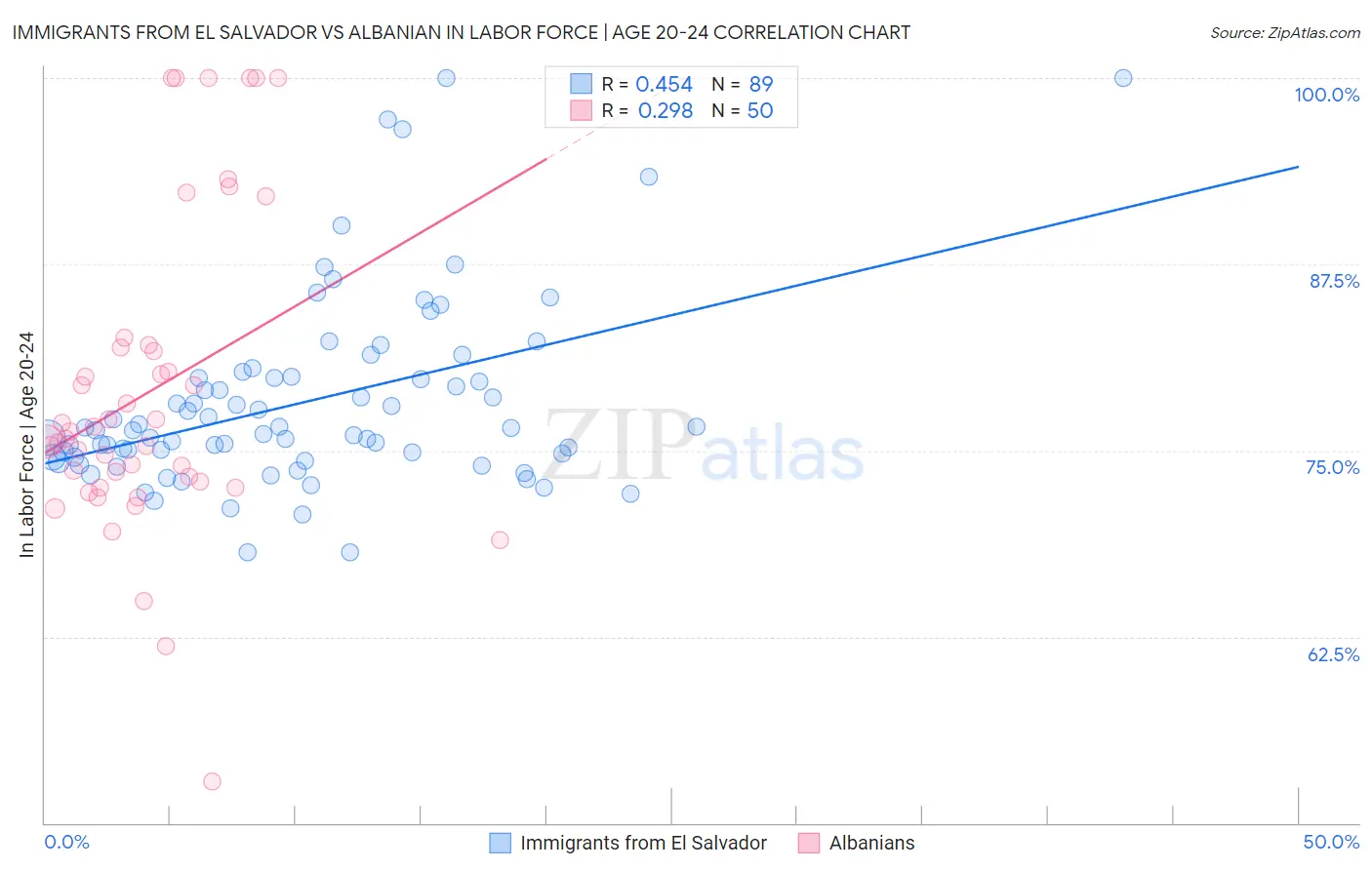Immigrants from El Salvador vs Albanian In Labor Force | Age 20-24
COMPARE
Immigrants from El Salvador
Albanian
In Labor Force | Age 20-24
In Labor Force | Age 20-24 Comparison
Immigrants from El Salvador
Albanians
75.3%
IN LABOR FORCE | AGE 20-24
71.7/ 100
METRIC RATING
156th/ 347
METRIC RANK
74.6%
IN LABOR FORCE | AGE 20-24
16.2/ 100
METRIC RATING
207th/ 347
METRIC RANK
Immigrants from El Salvador vs Albanian In Labor Force | Age 20-24 Correlation Chart
The statistical analysis conducted on geographies consisting of 357,704,995 people shows a moderate positive correlation between the proportion of Immigrants from El Salvador and labor force participation rate among population between the ages 20 and 24 in the United States with a correlation coefficient (R) of 0.454 and weighted average of 75.3%. Similarly, the statistical analysis conducted on geographies consisting of 193,237,710 people shows a weak positive correlation between the proportion of Albanians and labor force participation rate among population between the ages 20 and 24 in the United States with a correlation coefficient (R) of 0.298 and weighted average of 74.6%, a difference of 0.95%.

In Labor Force | Age 20-24 Correlation Summary
| Measurement | Immigrants from El Salvador | Albanian |
| Minimum | 68.1% | 52.8% |
| Maximum | 100.0% | 100.0% |
| Range | 31.9% | 47.2% |
| Mean | 78.3% | 79.0% |
| Median | 76.4% | 76.0% |
| Interquartile 25% (IQ1) | 74.5% | 72.9% |
| Interquartile 75% (IQ3) | 79.9% | 81.9% |
| Interquartile Range (IQR) | 5.4% | 9.0% |
| Standard Deviation (Sample) | 6.3% | 10.5% |
| Standard Deviation (Population) | 6.3% | 10.4% |
Similar Demographics by In Labor Force | Age 20-24
Demographics Similar to Immigrants from El Salvador by In Labor Force | Age 20-24
In terms of in labor force | age 20-24, the demographic groups most similar to Immigrants from El Salvador are Immigrants from Guatemala (75.3%, a difference of 0.0%), Immigrants from Western Europe (75.3%, a difference of 0.0%), Guatemalan (75.3%, a difference of 0.010%), Osage (75.3%, a difference of 0.010%), and Immigrants from Bolivia (75.3%, a difference of 0.010%).
| Demographics | Rating | Rank | In Labor Force | Age 20-24 |
| Ugandans | 76.1 /100 | #149 | Good 75.4% |
| Salvadorans | 74.8 /100 | #150 | Good 75.3% |
| Paiute | 74.1 /100 | #151 | Good 75.3% |
| Lebanese | 73.5 /100 | #152 | Good 75.3% |
| Guatemalans | 72.3 /100 | #153 | Good 75.3% |
| Osage | 72.3 /100 | #154 | Good 75.3% |
| Immigrants | Guatemala | 71.9 /100 | #155 | Good 75.3% |
| Immigrants | El Salvador | 71.7 /100 | #156 | Good 75.3% |
| Immigrants | Western Europe | 71.5 /100 | #157 | Good 75.3% |
| Immigrants | Bolivia | 71.0 /100 | #158 | Good 75.3% |
| South American Indians | 69.0 /100 | #159 | Good 75.3% |
| Japanese | 68.7 /100 | #160 | Good 75.3% |
| New Zealanders | 65.4 /100 | #161 | Good 75.2% |
| Immigrants | Romania | 64.6 /100 | #162 | Good 75.2% |
| Costa Ricans | 64.2 /100 | #163 | Good 75.2% |
Demographics Similar to Albanians by In Labor Force | Age 20-24
In terms of in labor force | age 20-24, the demographic groups most similar to Albanians are Immigrants from Uruguay (74.6%, a difference of 0.010%), Arab (74.6%, a difference of 0.010%), Sioux (74.6%, a difference of 0.030%), Uruguayan (74.6%, a difference of 0.030%), and Immigrants from Northern Africa (74.6%, a difference of 0.040%).
| Demographics | Rating | Rank | In Labor Force | Age 20-24 |
| Nigerians | 21.9 /100 | #200 | Fair 74.7% |
| Choctaw | 21.4 /100 | #201 | Fair 74.7% |
| Moroccans | 20.4 /100 | #202 | Fair 74.7% |
| Immigrants | Northern Africa | 17.9 /100 | #203 | Poor 74.6% |
| Immigrants | Italy | 17.6 /100 | #204 | Poor 74.6% |
| Inupiat | 17.6 /100 | #205 | Poor 74.6% |
| Sioux | 17.5 /100 | #206 | Poor 74.6% |
| Albanians | 16.2 /100 | #207 | Poor 74.6% |
| Immigrants | Uruguay | 15.8 /100 | #208 | Poor 74.6% |
| Arabs | 15.8 /100 | #209 | Poor 74.6% |
| Uruguayans | 15.1 /100 | #210 | Poor 74.6% |
| Immigrants | Australia | 14.7 /100 | #211 | Poor 74.6% |
| Creek | 13.3 /100 | #212 | Poor 74.5% |
| Peruvians | 13.3 /100 | #213 | Poor 74.5% |
| Immigrants | Southern Europe | 13.2 /100 | #214 | Poor 74.5% |